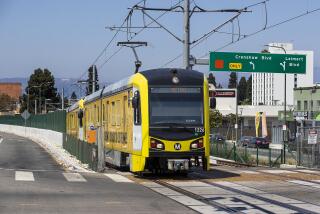CCDC Board Against Closing C Street for Trolley
- Share via
Centre City Development Corp. directors voted Friday to recommend to the City Council that the Metropolitan Transit Development Board seek an alternative to its plan to close two sections of C Street to make room for San Diego Trolley stations.
The action, supported by San Diegans Inc., a downtown planning group, calls on the MTDB to revamp its trolley station design to prevent the closing of C Street between 1st and 2nd avenues, and between 5th and 6th avenues.
Instead, the redevelopment agency officials recommended in a proposal that will go before the City Council on Feb. 25 that MTDB develop a one-track loop that would circle the downtown area or that C Street be widened by removal of landscaping and sidewalks. Both proposals would keep at least one lane of C Street open to auto traffic.
Arguing against the closure, Jim Schmidt of San Diegans Inc. disputed the city Planning Commission’s contention that closing C Street would not increase traffic significantly on adjoining streets.
“If we partly close C Street, that’s tantamount to full closure,” Schmidt said. “Ninety percent of the people coming to downtown come via cars and C Street is . . . a key route that ties into freeways taking people (in and) out of downtown.”
Claiming that nine of downtown’s 13 routes to freeway access include part of C Street, Schmidt said the traffic congestion caused by closing the street would run counter to the goals of downtown redevelopment.
“There’s going to be a lot of growth in the western end of downtown,” he said. “So, if we just sit here and piecemeal street after street, I think we’re going to be another L.A. or San Francisco, and that’s the last thing we want.”
Although MTDB eventually plans to make the trolley system a loop with two tracks--with trains traveling simultaneously in both directions--Rick Thorpe, director of engineering and construction for MTDB, said a single loop is impractical.
“You’re forcing people out of direction,” he said, citing a hypothetical example of people commuting to San Diego City College from the south. “On the return home, instead of going directly south and out of town, they’d have to go all the way down C Street, three or four miles out of their direction.”
However, Roy Potter, executive vice president of San Diegans Inc., said that single-loop mass transit systems have proved successful in cities such as Sydney, Australia, and Vienna, Austria.
The MTDB staff “says that San Diegans Inc. doesn’t have any expertise. I think they’re wrong,” said Potter, adding that he has studied the mass transit systems of numerous foreign cities. “I don’t think the MTDB staff has very much experience traveling around and seeing these things.”
Thorpe said that Potter’s examples, while deserving of closer study, are probably not applicable to the San Diego trolley system.
“Sydney, Australia, is not San Diego, California,” he said. “You have to know the specifics of what’s going on, whether it’s a three-block loop or a 10-mile loop.”
Despite his objections to the CCDC proposals, Thorpe said he would try to incorporate the agency’s recommendations into the trolley design. He warned, however, that MTDB is running out of time.
“If we keep delaying a decision, we’re either going to delay the opening of the trolley to the east or we’ll open it with the C Street work not done and we’ll have to close down all of C Street,” he said. “We’ve worked for a number of years to come up with a design that would accommodate automobiles and transit. It’s a compromise that we feel will satisfy both.”
In discussing the use of both trolley tracks Thorpe said said city traffic standards and the trolley system’s design make it impossible to accommodate both an automobile lane and the trolley stations on the two blocks proposed for closing.
Thorpe said the only way to keep C Street completely open would be to limit trolley station platforms to 6 1/2 feet in width. He explained that the platforms must be at least 10 feet wide to allow trolley riders in wheelchairs to board and disembark from the cars.
But, according to the CCDC staff, it would be possible to build a 9 1/2-foot-wide platform by removing a three-foot buffer zone of trees between the sidewalk and the street.
“I can’t understand why we need a buffer zone on one street,” said Gerald Trimble, executive vice president of CCDC.
Thorpe responded that without the buffer, pedestrians on the outer edge of the sidewalk would run the risk of being struck by the rear-view mirrors on wide vehicles, such as trucks. The fact that 90% of downtown visitors arrive by car is an argument for, rather than against, closing C Street, Thorpe said.
“Our whole goal is to change that 90%, to bring more people downtown but have fewer cars,” Thorpe said.
As an alternative to eliminating the three-foot buffer, CCDC’s staff recommended narrowing the trolley right-of-way by converting the system to a one-track loop around downtown, using the existing C Street and 12th Avenue right-of-way and extending the tracks along Harbor Drive and north to the Santa Fe Depot. Proponents of the single loop argue that, since the trains would be traveling in only one direction, the traffic blockage caused by trolleys crossing downtown streets would be greatly reduced.
More to Read
Sign up for Essential California
The most important California stories and recommendations in your inbox every morning.
You may occasionally receive promotional content from the Los Angeles Times.













